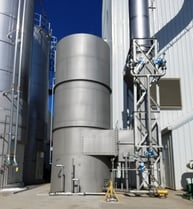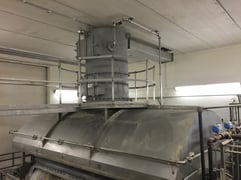Since the types and mechanisms of air pollution are always changing, the equipment used to control the air pollutants that we make must change and evolve as well.
Here at Sly we know that better than anyone. With over a century-and-a-half experience in the air pollution industry, our technology has come a long way since our original patent for the first cloth dust collector back in 1902. However, even before that, nature had its own way of cleaning the air: rain. You get that crisp, clean air feeling after it rains because it’s literally scrubbing pollutants from the air, essentially making it a rudimentary version of the modern wet scrubber. From those humble origins, wet scrubbers have evolved to become critical for our industrial needs of pollution control.
A wet scrubber is an air pollution control (APC) device that uses a scrubbing fluid or solution to remove contaminants from an air stream. This solution can be water-based or non-aqueous, allowing the device to remove a variety of solid, liquid, and gas contaminants. You can find wet scrubbers in numerous industrial applications such as industrial boilers, incinerators, and metals processing, as well as chemical, asphalt, and fertilizer production. While wet scrubbers can vary from application to application, these are the top 3 most common types of wet scrubbers:
Venturi Wet Scrubbers
 Venturi scrubbers are perfect for collecting fine particulate and liquid mists. Using the differential between high velocity gases and free-flowing water to create contaminant-entrapping droplets, these scrubbers can suspend and contain a multitude of pollutants in your system. By maintaining high gas velocities and turbulence in the throat of the design you can achieve high collection efficiencies, ranging from 90% to 99% for particles with a diameter larger than 1 µm and greater than 80% for submicron particles.
Venturi scrubbers are perfect for collecting fine particulate and liquid mists. Using the differential between high velocity gases and free-flowing water to create contaminant-entrapping droplets, these scrubbers can suspend and contain a multitude of pollutants in your system. By maintaining high gas velocities and turbulence in the throat of the design you can achieve high collection efficiencies, ranging from 90% to 99% for particles with a diameter larger than 1 µm and greater than 80% for submicron particles.
Packed Tower Wet Scrubbers
Packed tower scrubbers, also called packed bed or packed column scrubbers, are best for getting rid of gas phase emissions like sulfur dioxide or other odors and acids. By chemical scrubbing contaminants from your gas streams, these types of scrubbers, when designed correctly, can remove toxic or otherwise harmful emissions from gas streams and exhaust clean air into the environment. Internal packing within the scrubber provides a large wetted surface area that forces a close-contact interaction between the scrubbing liquid and the contaminated airflow. The scrubbing liquid then either absorbs or reacts with the contaminants, effectively removing them from the air. The typical collection efficiency range is from 90% to 99%, with that efficiency becoming greater than 99% for select pollutant systems. Packed tower scrubbers are less effective when dealing with particulate matter control, as high concentrations of dust can easily clog the bed of the tower.
Impingement Wet Scrubbers
 Also called tray-tower scrubbers, impingement scrubbers are your go-to devices for dealing with practically any other type of particulate matter with particles larger than 5 µm or soluble gases. They especially excel when working with dryers and powdered products, like salt and food flavorings. In these types of scrubbers, gas enters from the bottom of the tower and travels upward through openings in horizontal perforated trays while a scrubbing liquid flows from the top and over each tray, mixing with the gas. This produces more gas-liquid contact than in other tower designs.
Also called tray-tower scrubbers, impingement scrubbers are your go-to devices for dealing with practically any other type of particulate matter with particles larger than 5 µm or soluble gases. They especially excel when working with dryers and powdered products, like salt and food flavorings. In these types of scrubbers, gas enters from the bottom of the tower and travels upward through openings in horizontal perforated trays while a scrubbing liquid flows from the top and over each tray, mixing with the gas. This produces more gas-liquid contact than in other tower designs.
Improving upon typical tray scrubbers, the team at Sly has come up with our own type of scrubber called the Impinjet. Our secret is in the design of the scrubber itself, which uses an impingement baffle above each hole in the trays. During the air-scrubbing process, these wetted baffles create tiny droplets around 100 microns in diameter to clean the contaminated gas and entrap the pollutant particles in the scrubbing liquid. Through this design, Impinjet scrubbers can achieve high collection efficiencies of around 99% at 5 microns or larger through low water recirculation and minimum pressure drops.
No matter what industry you’re in or what type of pollutants you’re dealing with, picking the right wet scrubber for the job will be key to getting the most out of your air pollution control system.
Tags: wet scrubber




